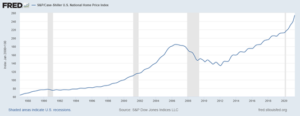Part one of a two-part series.
For home sellers, life has never been better. For home buyers, panic may be setting in, as housing prices jumped at an annual rate of 23.4% in June, according to the National Association of Realtors (NAR).
With demand for housing far outstripping supply, bidding wars have become common. Buyers sometimes pay six figures over the asking price and waive inspections. Houses have been selling nearly as fast as they are listed, and some buyers are bidding on homes they’ve never seen in person.
Given rising costs, low-income Americans in need of housing are likely finding the American dream of home ownership more elusive than ever.
How much a home sells for today depends on which data you want to believe. The National Association of Realtors reported that the median existing-home price for all housing in June was $363,300. Zillow says the average price of a home today is just $287,148, while Statista says it’s $408,800. The St. Louis Fed, meanwhile, found that the median sales price of a home jumped from $322,600 in the second quarter of 2020 to $374,900 a year later – an increase of 16.2%.
The varying estimates are irrelevant in Massachusetts, which has the third-highest housing prices in the country, with an average home selling for $439,541.
The statistics may vary, but it’s clear that housing is becoming unaffordable for a growing number of Americans. Yet the federal government, which dedicates tremendous resources to providing Americans with affordable housing, deserves much of the blame for today’s housing prices. State and local governments are also complicit.
Federal Role
To understand how the federal government is fueling today’s high housing prices, it helps to understand its role in housing and its history, at least leading up to the Great Recession.
The federal government spends billions of dollars a year trying to ensure that Americans have access to affordable housing. Federal agencies provide grants, vouchers, tax credits and more to help keep housing affordable. During the pandemic, there’s even been a moratorium on evicting tenants who fail to pay their rent.
The Department of Housing and Urban Development’s (HUD) Section 8 program provides more than $50 billion a year primarily for rental assistance. HUD also includes the Federal Housing Administration, which insures mortgages. The Community Reinvestment Act (CRA) was passed in 1977 to ensure that banks no longer “redline” to deny mortgages in poor neighborhoods.
The federal government also created Fannie Mae and Freddie Mac, government sponsored enterprises (GSEs) to provide “liquidity, stability and affordability” to the housing market. After the Great Recession, the government created the Federal Housing Finance Agency to oversee Fannie and Freddie, as well as 11 federal home loan banks.
The FHA also has relationships with hundreds of HUD-approved nonprofit organizations throughout the country “to ensure that financing is available to provide housing opportunities to low- to moderate-income families.”
The Great Recession
Leading up to the Great Recession, the Federal Reserve Board lowered interest rates to near zero, causing housing prices to rise.
“Faced with the bursting of the dot-com bubble, a series of corporate accounting scandals, and the September 11 terrorist attacks, the Federal Reserve lowered the federal funds rate from 6.5% in May 2000 to 1% in June 2003,” according to Investopedia. “The aim was to boost the economy by making money available to businesses and consumers at bargain rates. The result was an upward spiral in home prices as borrowers took advantage of the low mortgage rates.”
The bursting of the housing bubble that brought on the Great Recession revealed some of the flaws in the federal government’s housing programs.
While lenders were relaxing underwriting standards to the point where practically anyone could obtain a mortgage, it should have been no surprise when housing prices jumped and trillions of dollars in mortgages reached junk status. With homeowners having mortgages they couldn’t afford to pay off, foreclosures soared, housing prices dropped and home builders stopped building. In many cases, housing was “under water,” with the mortgage higher than the house was worth.
The subprime mortgage loans were typically bundled in “tranches” and sold to Fannie Mae or Freddie Mac. When the mortgages proved to be practically worthless, Fannie and Freddie were forced into “conservatorship,” handing over the management of their affairs to the FHFA.
When he announced the action of forcing the GSEs into conservatorship, U.S. Treasury Secretary Henry M. Paulson, said, “I attribute the need for today’s action primarily to the inherent conflict and flawed business model embedded in the GSE structure, and to the ongoing housing correction.”
In response to the Great Recession, the Federal Reserve Board began buying billions of dollars’ worth of bonds to reduce interest rates to near-zero, in part to stabilize the housing market.
